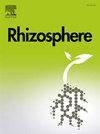Modeling root effects on soil detachment capacity using critical flow depth and unit energy of cross section in soils under Fraxinus excelsior L. species
IF 3.4
3区 生物学
Q1 PLANT SCIENCES
引用次数: 0
Abstract
The flow depth is an important hydraulic parameter for calculating other hydraulic parameters of overland flow. There is notable changes in hydraulic parameter when the roots of a plant develop in the topsoil. A power regression equation between soil detachment capacity (Dc) and unit energy of cross section (UEC) was established in soils under Fraxinus excelsior L. species based on the Froude number. For measuring Dc, samples collected from soils under the studied species and subjected to five slopes (from 13.9 to 33.9%) and five water discharges (from 0.39 to 0.77 L m−1 s−1) by a hydraulic flume. Compared with the soil with absence of root, the soil with presence of root had lower Dc. The results showed a strong power relationship between the unit energy of cross section and Dc, suggesting that soil detachment rate in rill erosion can be estimated using this hydraulic parameter (R2 = 0.84). This finding is particularly relevant for hillslopes with slopes from 12% to 31%, where the proposed mathematical model could be applied to predict Dc. Overall, this investigation supports a broader use of native species (such as the european ash Fraxinus excelsior L.), as a useful eco-engineering conservation practice and an alternative technique instead of utilizing artificial and expensive conservation practices.
利用 Fraxinus excelsior L. 树种下土壤的临界流深和横截面单位能模拟根系对土壤剥离能力的影响
水流深度是计算陆地流其他水力参数的一个重要水力参数。当植物的根系在表土中生长时,水力参数会发生显著变化。根据弗劳德数,建立了 Fraxinus excelsior L. 树种下土壤的脱离能力(Dc)与横截面单位能量(UEC)之间的幂回归方程。为测量 Dc,从所研究树种下的土壤中采集了样本,并通过水槽对其进行了五次斜坡(从 13.9% 到 33.9%)和五次排水(从 0.39 到 0.77 L m-1 s-1)试验。与无根土壤相比,有根土壤的 Dc 值较低。结果表明,横截面单位能量与 Dc 之间存在很强的幂函数关系,这表明可以利用这一水力参数(R2 = 0.84)来估算碾压侵蚀中的土壤剥离率。这一发现尤其适用于坡度在 12% 到 31% 之间的山坡,在这些山坡上,所提出的数学模型可用于预测 Dc。总之,这项调查支持更广泛地使用本地物种(如欧洲白蜡树),将其作为一种有用的生态工程保护措施和替代技术,而不是使用人工和昂贵的保护措施。
本文章由计算机程序翻译,如有差异,请以英文原文为准。
求助全文
约1分钟内获得全文
求助全文
来源期刊

Rhizosphere
Agricultural and Biological Sciences-Agronomy and Crop Science
CiteScore
5.70
自引率
8.10%
发文量
155
审稿时长
29 days
期刊介绍:
Rhizosphere aims to advance the frontier of our understanding of plant-soil interactions. Rhizosphere is a multidisciplinary journal that publishes research on the interactions between plant roots, soil organisms, nutrients, and water. Except carbon fixation by photosynthesis, plants obtain all other elements primarily from soil through roots.
We are beginning to understand how communications at the rhizosphere, with soil organisms and other plant species, affect root exudates and nutrient uptake. This rapidly evolving subject utilizes molecular biology and genomic tools, food web or community structure manipulations, high performance liquid chromatography, isotopic analysis, diverse spectroscopic analytics, tomography and other microscopy, complex statistical and modeling tools.
 求助内容:
求助内容: 应助结果提醒方式:
应助结果提醒方式:


